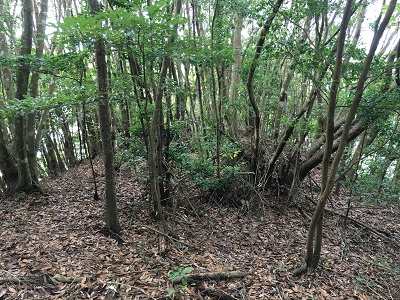 Agroforest
Challenges Agroforest
Challenges
This is a list of what we consider to be the most challenging aspects of our
agroforestry project in no particular order. Since purchasing and working on the
mountains we have dealt with deer and insects eating our crops, poisonous
snakes, huge giant Japanese hornets, sloping topography, and a host of other
issues. Details about the most challenging of the challenges follows.
|
|
|
- Forest - The main
challenge of our agroforestry project is....um....the forest. Might sound
kinda funny but the challenges inherent in trying to grow anything in a
space with 40 meter tall trees and their extensive root systems is
challenging....to say the least.
- Deer - Many of the farms
on the road to the mountains are using some type of deer resistant metal or
netting. That said, so far there is no evidence of deer on our property. We
actually put in a couple beds of sweet potato vines as a test....we'll see.
- Sloping topography -
Although difficult, we plan to use the concepts of terrace farming and
intercropping to overcome this "slight" inconvenience.
- Soil - Purchasing a
forest that has been, as far as we know, unused for centuries presents a bit
of a challenge when it comes to growing anything except trees with deep root
systems. The challenge is mountain soil covered with a very thick layer of
humus, which is dark, organic material that forms in soil when plant and
animal matter decays. Although loaded with nutrients, the lightweight nature
of the humus prohibits delicately rooted crops from really getting a good
hold of the ground. The mountain soil needs to be thoroughly mixed with the
humus before it can be used.
- Sunlight - The mountain
has an unbelievable canopy formed mostly by the Japanese cypress, Japanese
cedar, and Japanese oak trees. The forest floor receives limited, filtered
sunlight at best. The understory trees further reduce the amount of sunlight
reaching the soil. The plan is to remove most of the understory trees and
shrubs before leveling areas for food production.
|
|
Specific
Challenges
This is a list of what we consider to be the most challenging aspects of our
agroforestry project in no particular order. Since purchasing and working on the
mountains we have dealt with deer and insects eating our crops, poisonous
snakes, huge giant Japanese hornets, sloping topography, and a host of other
issues. Details about the most challenging of the challenges follows.
A Bit About Our Mountain
We are already supplying close to 100% of our fresh food needs with our farms
and now it was time for the next step, which in this case, meant buying a
forested mountain. The mountain backs to a reservoir which supplies drinking and
irrigation water to the northern section of the island. The total land area of
the mountain is over 18,000 square meters, which is about 193,750 square feet
for those of you still using the Imperial measuring system, or about 4.5 acres.
The mountain is loaded with hinoki, sugi, and oak trees and has beautiful views
of the reservoir. Public facilities are located directly across the reservoir
and include a huge park, sports fields, a community center, and several
bathrooms. A small cabin style bathroom is located a mere 4 minute walk from our
property in a small park and includes flush toilets, a public source of drinking
water, and picnic tables.
What is an Agroforest?
The Wikipedia definition is: An agroforest, or more specifically Agroforestry,
is a land use management system in which trees or shrubs are grown around or
among crops or pastureland. Although I agree with this definition to some
extent, it seems like adding trees to existing farmland is nothing more than a
glorified windbreak. For me, real agroforestry is more in the form of
transforming an existing mountain forest into a productive, yet sustainable,
ecosystem where the native trees are kept undisturbed with crops being the new
introduction....not the trees.
Our Progress
The work on our agroforestry project seems slow, but after a year and a half of
work, we were able to grow our first crops during the Summer of 2023. During
that same Summer, a typhoon wiped out much of our crops but we were still able
to salvage quite a bit. The project has been difficult from the beginning due to
the many challenges we faced, and continue to face, along the way.
Challenges
The work on our agroforest has been hampered by numerous challenges both
personal and situational.
Personal Challenges
Probably the most difficult personal challenge has been working on our
agroforest with three kids. As of 2023 they turned 14, 7, and 3 years old.
Meeting their needs and still trying to be productive is a difficult balancing
act. That said, They are very cooperative, they help a lot, especially our
oldest son, and all of them enjoy our family time up in our mountain. On a more
personal note, I am 63 years old as of 2023 and my wife is 43 years old. My
physical condition has made the work on the agroforest painful but I still
manage to put in full work days when we are up there. A few years a go I
incurred an inguinal hernia, not long after a bicep injury to my right arm, and
during the Summer of 2019 developed symptoms of rheumatoid arthritis. The hernia
has become tolerable, the bicep injury is somewhat limiting my strength, and I
am managing the arthritis through exercise and diet. The reasons for not dealing
with these problems are many and will be discussed in a future post. |
|
|
|
|
|
|